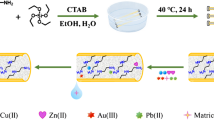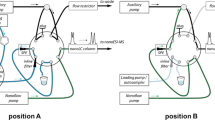Abstract
We describe the development and optimization of a sensitive and selective screening method for the measurement of trace levels of microcystins in surface waters. Several sample preparation techniques were compared, including solid-phase microextraction (SPME), particle-based solid-phase extraction (SPE), and monolith-based SPE. A flow-injection (FI) based approach employing a reversed-phase monolithic SPE column was found to be optimal. Quantification was performed by directly interfacing the FI-based SPE system to an electrospray ionization-mass spectrometer (ESI-MS). To more safely simulate peptidyl toxins such as the microcystins, a model peptide (i.e., angiotensin II) was used for method optimization. Sample loading flow rate and volume, eluent composition, and elution flow rate were optimized. Sample throughput was six samples per hour, a detection limit of 1.31 ng angiotensin II was demonstrated for a linear dynamic range from 1–1,000 ng and 3.4% relative standard deviation (n = 4, 100 ng sample). Sample volumes up to 1,000 ml of surface water could be loaded onto the monolithic SPE disk without exceeding the sorbent’s capacity. Unlike conventional particle-based SPE methods, the monolithic SPE disk does not need to be replaced between samples and could be used indefinitely. The FI-based SPE-ESI-MS method was successfully applied to the determination of microcystin-LR, the most common of the microcystins, in environmental samples and was demonstrated for the direct monitoring of chlorinated drinking water, with trends tracked over a period of eight months.








Similar content being viewed by others
References
Peréz S, Aga D (2005) Recent advances in the sample preparation, liquid chromatography tandem mass spectrometric analysis and environmental fate of microcystins in water. Trends Anal Chem 24:658
Kondo F, Ito Y, Oka H, Yamada S, Tsuji K, Imokawa M, Niimi Y, Harada K, Ueno Y, Miyazaki Y (2002) Determination of microcystins in lake water using reusable immunoaffinity column. Toxicon 40:893
Aranda-Rodriguez R, Kubwabo C, Benoit FM (2003) Extraction of 15 microcystins and nodularin using immunoaffinity columns. Toxicon 42:587
Aguete EC, Gago-Martinez A, Leao JM, Rodriguez-Vazquez JA, Menard C, Lawrence JF (2003) HPLC and HPCE analysis of microcystins RR, LR and YR present in cyanobacteria and water by using immunoaffinity extraction. Talanta 59:697
Lawrence JF, Menard C (2001) Determination of microcystins in blue-green algae, fish and water using liquid chromatography with ultraviolet detection after sample clean-up employing immunoaffinity chromatography. J Chromatogr A 922:111
Lawton LA, Edwards C, Codd GA (1994) Extraction and high-performance liquid-chromatographic method for the determination of microcystins in raw and treated waters. Analyst 119:1525
Rivasseau C, Martins S, Hennion MC (1998) Determination of some physicochemical parameters of microcystins (cyanobacterial toxins) and trace level analysis in environmental samples using liquid chromatography. J Chromatogr A 799:155
Karlsson KM, Spoof LEM, Meriluoto JAO (2005) Quantitative LC-ESI-MS analyses of microcystins and nodularin-R in animal tissue-matrix effects and method validation. Environ Toxicol 20:381
Ott JL, Carmichael WW (2006) LC/ESI/MS method development for the analysis of hepatotoxic cyclic peptide microcystins in animal tissues. Toxicon 47:734
Poon KF, Lam MHW, Lam PKS, Wong BSF (2001) Determination of microcystins in cyanobacterial blooms by solid-phase microextraction-high-performance liquid chromatography. Environ Toxicol Chem 20:1648
Lee HS, Jeong CK, Lee HM, Choi SJ, Do KS, Kim K, Kim YH (1999) On-line trace enrichment for the simultaneous determination of microcystins in aqueous samples using high-performance liquid chromatography with diode-array detection. J Chromatogr A 848:179
Rivasseau C, Vanhoenacker G, Sandra P, Hennion MC (2000) On-line solid-phase extraction in microcolumn-liquid chromatography coupled to UV or MS detection: application to the analysis of cyanobacterial toxins. J Microcolumn Sep 12:323
Allis O, Dauphard JHB, Shuilleabhain AN, Lehane M, James KJ, Furey A (2007) Liquid chromatography-tandem mass spectrometry application, for the determination of extracellular hepatotoxins in Irish Lake and drinking waters. Anal Chem 79:3436
Pawliszyn J (1997) Solid phase microextraction: theory and practice. Wiley-VCH, New York
Maizels M, Budde WL (2004) A LC/MS method for the determination of cyanobacteria toxins in water. Anal Chem 76:1342
Diehnelt CW, Peterman SM, Budde WL (2005) Liquid chromatography-tandem mass spectrometry and accurate m/z measurements of cyclic peptide cyanobacteria toxins. Trends Anal Chem 24:622
Dahlmann J, Budakowski WR, Luckas B (2003) Liquid chromatography-electrospray ionisation–mass spectrometry based method for the simultaneous determination of algal and cyanobacterial toxins in phytoplankton from marine waters and lakes followed by tentative structural elucidation of microcystins. J Chromatogr A 994:45
Lawrence JF, Menard C (2001) Determination of microcystins in blue-green algae, fish and water using liquid chromatography with ultraviolet detection after sample clean-up employing immunoaffinity chromatography. J Chromatogr A 922:111
Zweigenbaum JA, Henion JD, Beattie KA, Codd GA, Poon GK (2000) Direct analysis of microcystins by microbore liquid chromatography electrospray ionization ion-trap tandem mass spectrometry. J Pharm Biomed Anal 23:723
Lawrence JF, Niedzwiadek B, Menard C, Lau BPY, Lewis D, Kuper-Goodman T, Carbone S, Holmes C (2001) Comparison of liquid chromatography/mass spectrometry, ELISA, and phosphatase assay for the determination of microcystins in blue-green algae products. J AOAC Int 84:1035
Nivsarkar M, Kaushik MP (2002) Liquid chromatography determination and LC-ESI-MS analysis of microcystin-LR from PCC strains of Microcystis aeruginosa. J Liq Chromatogr Relat Technol 25:865
Hummert C, Dahlmann J, Reinhardt K, Dang HPH, Dang DK, Luckas B (2001) Liquid chromatography—mass spectrometry identification of microcystins in Microcystis aeruginosa strain from Lake Thanh Cong, Hanoi, Vietnam. Chromatographia 54:569
Spoof L, Meriluoto J (2002) Rapid separation of microcystins and nodularin using a monolithic silica C-18 column. J Chromatogr A 947:237
Cousins IT, Bealing DJ, James HA, Sutton A (1996) Biodegradation of microcystin-LR by indigenous mixed bacterial populations. Water Res 30:481
Kaya K, Sano T, Inoue H, Takagi H (2001) Selective determination of total normal microcystin by colorimetry, LC/UV detection and/or LC/MS. Anal Chim Acta 450:73
Bateman KP, Thibault P, Douglas DJ, White RL (1995) Mass-spectral analyses of microcystins from toxic cyanobacteria using online chromatographic and electrophoretic separations. J Chromatogr A 712:253
Bouaicha N, Rivasseau C, Hennion MC, Sandra P (1996) Detection of cyanobacterial toxins (microcystins) in cell extracts by micellar electrokinetic chromatography. J Chromatogr B-Biomed Appl 685:53
Chorus I, Bartram J (1999) Toxic cyanbacteria in water: a guide to their public health consequences, monitoring, and management. E & FN Spon, London
Whitehouse CM, Dreyer RN, Yamashita M, Fenn JB (1985) Electrospray interface for liquid chromatographs and mass spectrometers. Anal Chem 57:675
Cole RB (1997) Electrospray ionization mass spectrometry: fundamentals, instrumentation, and applications. Wiley, New York
Oehrle SA, Westrick J (2003) Analysis of various cyanobacterial toxins by LC-MS. LC GC North America 21:634
Hormazabal V, Ostensvik O, Underdal B, Skulberg OM (2000) Simultaneous determination of the cyanotoxins anatoxin A, microcystin desmethyl-3-RR, LR, RR and YR in water using liquid chromatography–mass spectrometry. J Liq Chromatogr Relat Technol 23:3155
Cameán A, Moreno IM, Ruiz MJ, Picó Y (2004) Determination of microcystins in natural blooms and cyanobacterial strain cultures by matrix solid-phase dispersion and liquid chromatography–mass spectrometry. Analytical and Bioanalytical Chemistry 380:537
Jurczak T, Tarczyñska M, Karlsson K, Meriluoto J (2004) Characterization and diversity of cyano-bacterial hepatotoxins (microcystins) in blooms from polish freshwaters identified by liquid chromatography–electrospray ionisation mass spectrometry. Chromatographia 59:571
Siren H, Jussila M, Liu HW, Peltoniemi S, Sivonen K, Riekkola ML (1999) Separation, purity testing and identification of cyanobacterial hepatotoxins with capillary electrophoresis and electrospray mass spectrometry. J Chromatogr A 839:203
Chen J, Pawliszyn JB (1995) Solid-phase microextraction coupled to high-performance liquid chromatography. Anal Chem 67:2530
Lin HH, Sung YH, Huang SD (2003) Solid-phase microextraction coupled with high-performance liquid chromatography for the determination of phenylurea herbicides in aqueous samples. J Chromatogr A 1012:57
Lambropoulou DA, Sakkas VA, Hela DG, Albanis TA (2002) Application of solid-phase microextraction in the monitoring of priority pesticides in the Kalamas River (NW Greece). J Chromatogr A 963:107
Mullett WM, Pawliszyn J (2002) Direct determination of benzodiazepines in biological fluids by restricted-access solid-phase microextraction. Anal Chem 74:1081
Katayama M, Matsuda Y, Shimokawa K, Tanabe S, Hara I, Sato T, Kaneko S, Daimon H (2001) Determination of beta-blockers by high performance liquid chromatography coupled with solid phase microextraction from urine and plasma samples. Anal Lett 34:91
Kataoka H, Lord HL, Pawliszyn J (2000) Simple and rapid determination of amphetamine, methamphetamine, and their methylenedioxy derivatives in urine by automated in-tube solid-phase microextraction coupled with liquid chromatography-electrospray ionization mass spectrometry. J Anal Toxicol 24:257
Saito Y, Kawazoe M, Hayashida M, Jinno K (2000) Direct coupling of microcolumn liquid chromatography with in-tube solid-phase microextraction for the analysis of antidepressant drugs. Analyst 125:807
Gou YN, Eisert R, Pawliszyn J (2000) Automated in-tube solid-phase microextraction-high-performance liquid chromatography for carbamate pesticide analysis. J Chromatogr A 873:137
Walles M, Mullett WM, Pawliszyn J (2004) Monitoring of drugs and metabolites in whole blood by restricted-access solid-phase microextraction coupled to liquid chromatography-mass spectrometry. J Chromatogr A 1025:85
Fritz JS, Gjerde DT (2000) Ion chromatography. Wiley-VCH, New York
Small H (1989) Ion chromatography. Plenum, New York
Tanaka N, Kobayashi H, Nakanishi K, Minakuchi H, Ishizka N (2001) Monolithic LC columns. Anal Chem 73:420A
Svec F, Frechet JMJ (1999) Molded rigid monolithic porous polymers: an inexpensive, efficient, and versatile alternative to beads for the design of materials for numerous applications. Ind Eng Chem Res 38:34
Viklund C, Svec F, Frechet JMJ, Irgum K (1996) Monolithic, “molded”, porous materials with high flow characteristics for separations, catalysis, or solid-phase chemistry: control of porous properties during polymerization. Chem Mater 8:744
Leinweber FC, Tallarek U (2003) Chromatographic performance of monolithic and particulate stationary phases—hydrodynamics and adsorption capacity. J Chromatogr A 1006:207
Peters EC, Svec F, Frechet JMJ (1999) Rigid macroporous polymer monoliths. Adv Mat 11:1169
Snyder AP (2000) Interpreting protein mass spectra: a comprehensive resource. Oxford University Press, New York
Bobeldijk I, Stoks PGM, Vissers JPC, Emke E, van Leerdam JA, Muilwijk B, Berbee R, Noij THM (2002) Surface and wastewater quality monitoring: combination of liquid chromatography with (geno)toxicity detection, diode array detection and tandem mass spectrometry for identification of pollutants. J Chromatogr A 970:167
Wetzel RG (2001) Limnology: lake and river ecosystems. Academic, San Diego
Takino M, Kyono Y (2000) Application brief: LC/MS analysis of microcystins in freshwater by electrospray ionization. Agilent Technologies, Inc., USA
Acknowledgements
We thank Professor Colleen McDermott (University of Wisconsin–Oshkosh) for generously providing the samples of cyanobacteria. This work was supported by the UWM Center for Water Security. Presented in part at the 57th Pittsburgh Conference on Analytical Chemistry & Applied Spectroscopy, Orlando, FL (March 2004).
Author information
Authors and Affiliations
Corresponding author
Rights and permissions
About this article
Cite this article
Ammerman, J.L., Aldstadt, J.H. Monolithic solid-phase extraction for the rapid on-line monitoring of microcystins in surface waters. Microchim Acta 164, 185–196 (2009). https://doi.org/10.1007/s00604-008-0056-8
Received:
Accepted:
Published:
Issue Date:
DOI: https://doi.org/10.1007/s00604-008-0056-8




